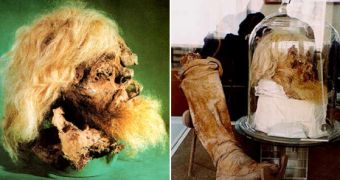The most famous mummies are the ancient Egyptian ones, which are the result of human manipulation. But nature, too, can deliver mummies in some special conditions like extreme cold, dryness, and a naturally occurring mix of chemicals that can impede the decomposition processes.
Low temperatures have preserved some Inca-era mummies in the Peruvian Andes Mountains, or corpses of natives in the subarctic islands of the Aleutian Islands. Bodies from the Iron Age (2,500 years old) have been discovered in northern European bogs, preserved by the water acidity, low temperatures, and lack of oxygen. In northwestern China, the dry desert preserved mummies over 2,000 years old of White race people that once inhabited the area.
Instead, in Iran, mummies have been preserved by salt. Another "natural mummy", the sixth one, has appeared in Chehrabad Salt Mine (Hamzehlu region , Zanjan, northwestern Iran). This is 1,800 years old, and was recently exposed to heavy rains pounding the salt mine. The man could have been a worker killed by falling rocks during an earthquake.
The other five "salt men" discovered in the same mine between 1993 and 2005, ranged from the Achaemenid period (539 to 333 B.C.) (Xerxes is the most famous king of this dynasty) to the Sasanian era (A.D. 240 to 640). The salt mummies delivered to the researchers scientific treasure troves, as their advanced state of preservation made their beards, hair and garments stay largely intact; some even had food in their stomach. But there is a concern about the extraction and preservation of the mummy.
Mohammad-Hassan Fazeli Nashli, director of the Iranian Centre of Archaeological Research, does not agree on the idea of digging up the new mummy, due to Iran's lack of equipment and facilities for preserving it. "There are still many serious problems in regard to the [five salt men's] preservation. Iran is still a novice in protection of artifacts. Thus, when there is no critical question, it is better if we let the artifact remain in the earth, which is the best trustee," Nashli told Iran's Cultural Heritage News Agency.
"The salt men is outstanding." said Thomas St?llner, a professor at the University of Bochum in Germany, who visited the mine and confirmed the request for assistance of Bochum's German Mining Museum by the Iranian archaeologists.
"European and Iranian scientists are planning to conduct a field study to work on documenting the mines and to study ancient plants in the site. Researchers have experience dealing with salt-preserved organic objects like tissue and fabrics, but most lack experience in dealing with entire human bodies. Nobody has experience with salt-conserved bodies worldwide. [We] need a complete new strategy on how to deal with them." said St?llner.
"There are many burials and cemeteries all over Iran, or indeed the Near East, with graves dating to these periods. But these graves don't contain soft tissue or hair, let alone leather clothing, bags, footwear, belts or ropes, horn and bone-handled knives, and other organic items preserved by salt", pointed out Daniel Potts, a specialist in Near Eastern archeology at the University of Sydney, Australia.
"If the Iranian government can collaborate with specialist laboratories and begin DNA analyses, then these salt men could provide a huge amount of important data on the entire millennium between the Persian Empire and the coming of Islam", Potts said.

 14 DAY TRIAL //
14 DAY TRIAL //